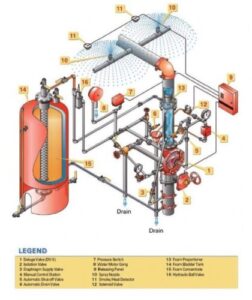Foam Systems Engineering Manual-Kidde Fire Fighting
Foam Systems Engineering Manual-Kidde Fire Fighting
Fire Fighting foam Systems is a stable aggregation of small bubbles of lower density than oil or water that exhibits a tenacity for covering horizontal surfaces. It flows freely over a burning liquid surface and forms a tough, air-excluding, continuous blanket that seals volatile vapors from access to air. It resists disruption from wind and draft or heat and flame attack and is capable of resealing in case of mechanical rupture.
All foam systems, regardless of size, consist of a foam concentrate supply, proportioning device, water supply, and foam maker(s). While all the components must function properly to ensure system performance, the foam concentrate is the most vital component of the system.
You can also read TYCO Safety Products FM-200 Gas System
Foam Systems Engineering Manual-Kidde Fire Fighting
- INDEX
![Foam Systems]()
- BASICS OF FOAM
- PROPORTIONING
- STORAGE TANK PROTECTION
- LOADING RACK PROTECTION
- AIRCRAFT HANGAR PROTECTION
- HELIPORT PROTECTION
- WAREHOUSE PROTECTION
- MARINE VESSELS & DRILLING RIG PROTECTION
- MARINE DOCK PROTECTION
The following summary provides recommendations for maintaining and monitoring foam concentrate integrity:
1. Keep the foam concentrate tank filled halfway within the expansion dome.
2. Provide a pressure-vacuum vent. A pressure vacuum vent reduces condensation and evaporation that are harmful to the foam concentrate. This vent requires periodic inspection and cleaning.
3. Avoid storage above the maximum recommended temperatures.
4. Never mix different brands or types of foam concentrates for long-term storage.
5. Avoid the dilution of foam concentrate with water.
6. Avoid contamination with foreign ingredients, chemicals or oils. Agitation, intermixing and improper application of Foam Seal may contaminate the foam concentrate. Contact NF for specific recommendations.
7. Valves, couplings or piping in continual contact with the foam concentrate should not be constructed of dissimilar metals. Dissimilar metals may cause rust, or galvanic corrosion.
8. Contact NF’s Technical Service Department for periodic analysis of your foam concentrate supplies.


Comments are closed.